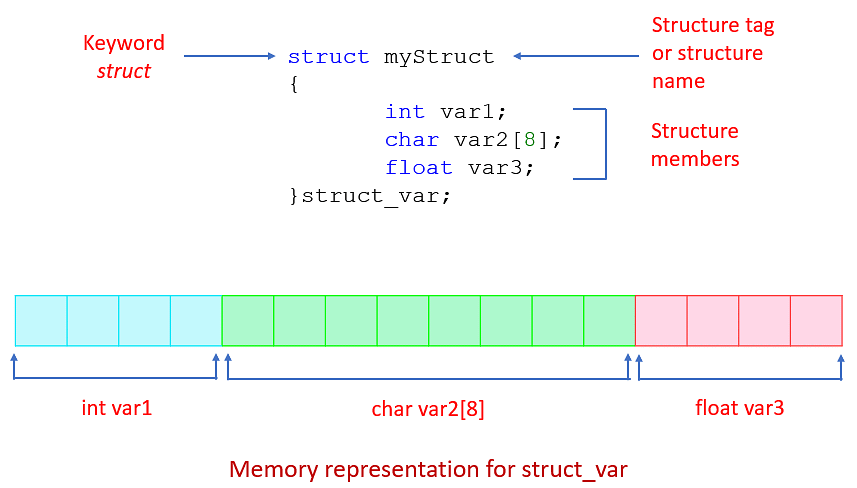In C, a structure is a composite data type that groups variables of different data types under a single name. It allows you to create custom data types that can store multiple variables of different data types as members within a single memory block. A structure is defined using the struct keyword followed by the structure name, and its members are listed within curly braces {}.
A structure can be represented as follows:
A structure can be implemented in C as follows:
struct Person {
char name[50];
int age;
float height;
};
In the example above, a structure named Person is defined with three members: name, age, and height. The name member is an array of characters with a maximum size of 50, representing the name of the person. The age member is an integer representing the age of the person, and the height member is a floating-point number representing the height of the person.
- Declaration: Structures are declared using a structure definition, which specifies the data members and their types. For example:
struct Point {
int x;
int y;
};
- Initialization: Structures can be initialized when they are declared or after they are declared. For example:
struct Point p1 = {0, 0}; // Initializing at declaration
struct Point p2; // Declaration
p2.x = 1; // Initialization after declaration
p2.y = 2;
- Accessing data members: You can access the data members of a structure using the dot (.) operator. For example:
struct Point p1 = {3, 4};
int x = p1.x; // Accessing the x data member
int y = p1.y; // Accessing the y data member
- Modifying data members: You can modify the data members of a structure using the dot (.) operator. For example:
struct Point p1 = {3, 4};
p1.x = 5; // Modifying the x data member
p1.y = 6; // Modifying the y data member
- Comparison: You can compare structures for equality or inequality using the equality (==) and inequality (!=) operators, respectively. For example:
struct Point p2 = {3, 4};
if (p1.x == p2.x && p1.y == p2.y) {
// p1 and p2 are equal
}
- Passing structures to functions: You can pass structures as arguments to functions, either by value or by reference. By value means a copy of the structure is passed, and by reference means a pointer to the structure is passed. For example:
void printPoint(struct Point p) {
printf("x: %d, y: %d\n", p.x, p.y);
}
struct Point p1 = {3, 4};
printPoint(p1); // Passing by value
void modifyPoint(struct Point* p) {
p->x = 5;
p->y = 6;
}
struct Point p2 = {3, 4};
modifyPoint(&p2); // Passing by reference
- Array of structures: You can create arrays of structures to store multiple instances of the same type of data. For example:
struct Point points[3]; // Array of 3 Point structures
points[0].x = 1;
points[0].y = 2;
points[1].x = 3;
points[1].y = 4;
points[2].x = 5;
points[2].y = 6;
Structures can also be defined within structures to create nested or hierarchical data structures. Structures are commonly used in C for organizing and storing data in a structured manner, such as representing complex objects, data records, or configurations.
The program in this repository demonstrates the implementation of a structure in C.
// A. creating a database of vehicles by storing information like:
// 1. name
// 2. manufacturing year
// 3. cost
// 4. category (high end (H) / middle (M) / low end (L))
// make a structure to store the above information about a vehicle.
#include <stdio.h>
// creating a structure and naming it 'car'
struct car
{
char name[50];
int mYear;
int cost;
char category;
};
struct car model[3];
int main()
{
// int i, j;
// declaring an array of the struct data type 'car' and calling it 'model'
// taking user input for the name, manufacturing year, cost and category
//printf("Name: ");
//scanf("%s", &model.name);
//printf("Manufacturing Year: ");
//scanf("%d", &model.mYear);
//printf("Cost: ");
//scanf("%d", &model.cost);
//printf("%s %d %d", model.name, model.mYear, model.cost);
/*
// storing details of 10 (3 for now) cars in an array
for(i = 0; i < 3; i++)
{
printf("Name: ");
scanf("%s", &model[i].name);
printf("Manufacturing Year: ");
scanf("%d", &model[i].mYear);
printf("Cost: ");
scanf("%d", &model[i].cost);
printf("\n\n\n");
}
printf("Available Database: \n\n");
printf("Name MYear Cost \n");
for(j = 0; j < 3; j++)
{
printf("%s %d %d \n", model[j].name, model[j].mYear, model[j].cost);
}
*/
userInput();
printInput();
return 0;
}
// B. make two functions: one takes user input, the other prints it
void userInput()
{
int i;
// storing details of 10 (3 for now) cars in an array
for(i = 0; i < 3; i++)
{
printf("Name: ");
scanf("%s", &model[i].name);
printf("Manufacturing Year: ");
scanf("%d", &model[i].mYear);
printf("Cost: ");
scanf("%d", &model[i].cost);
printf("\n\n\n");
}
}
void printInput()
{
int j;
printf("Available Database: \n\n");
printf("Name MYear Cost \n");
for(j = 0; j < 3; j++)
{
printf("%s %d %d \n", model[j].name, model[j].mYear, model[j].cost);
}
}
